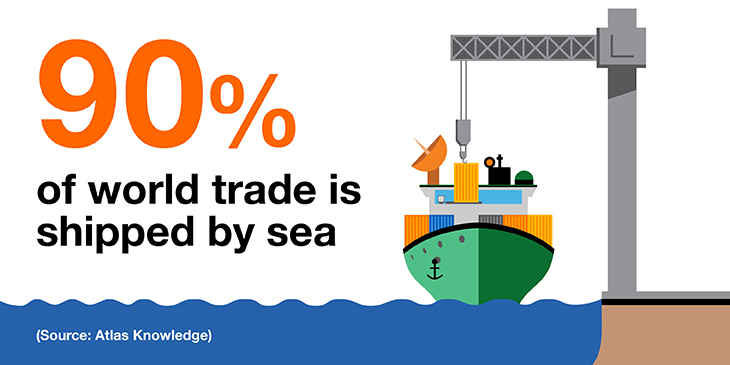5G has the potential to enable all kinds of new applications within ports, such as smart drones for real-time monitoring, real-time ship-to-shore communication for port-to-vessel traffic management, and just-in-time operations. Ports could accelerate the deployment and adoption of autonomous vessels thanks to 5G's low latency.
At present, typical port operations tend to be limited by the amount of data and information sharing they're able to do using current technologies. They generally rely on fiber optic cabling, supported by 3G or 4G mobile connectivity around the port. These networks enable some helpful use cases but are insufficient for full automation. 5G is a platform for creating a smart port.

What else could 5G enable in smart ports?
5G can enable ports to connect and monitor far more data sources in real time than ever before. This includes specific areas of ports, vessel movements, shipping containers, and more. In a smart port, 5G supports communications that can help ports optimize operations like loading and offloading vessels when they have arrived.
Ports need to monitor cargo and ships when they are at sea, and satellite 5G will, when it is mature enough, allow them to use data to get full visibility of cargo in transit. IoT-connected sensors affixed to shipping containers and even pallets of goods themselves will, over time, enable companies to know exactly where goods are at any given moment. Remote-controlled gantry and quayside cranes can also benefit, as 5G will support real-time management, with no interruptions, as can occur with human crane operators.
5G also means the scope for smart ports to deploy state-of-the-art cameras and programmable logic controllers (PLCs) on cranes, allowing for more precise movement, lifting and container pickup. IoT use cases will be made more viable, thanks to 5G being able to reliably power geolocation of port assets, whether containers or haulage vehicles, around the site. 5G can also provide the connectivity needed to enable virtual (VR) and augmented reality (AR) for remote ship maintenance.
The growing role of data analytics in ports
With 5G empowering all these new connected tools and objects around the smart port, vast amounts of data will be generated. This output can be analyzed then used to enhance port operations on a continuing basis.
Data gathered from connected objects in a port can enable new use cases like container stacking optimization, freight pricing optimization, streamlined crew rostering and more. Data analytics can also analyze information gathered from drone cameras deployed around a port to help address harbor environmental compliance issues. Data will play an increasingly important role in smart ports as they deploy 5G and uncover new use cases to optimize existing practices and processes.
Smart ports already transforming maritime
Orange has built a private 5G network in the Port of Antwerp in Belgium, one of the world's biggest, busiest ports, to help the port transform operations. The project will automate key port activities and give real-time visibility of logistics movements in supply-chain ecosystems that use the facility. The aim is to enable the industrial and consumer companies, ships and logistics firms that use the port to collaborate more efficiently and safely in real time.
The private 5G network covers 150 square kilometers. The port authority is trialing automated tugs that guide container ships to and from berths, with all boats equipped with HD cameras to detect irregularities such as oil spillages. Port of Antwerp is also exploring the potential of autonomous barges, autonomous drones, robots and augmented and virtual reality (AR and VR). Over time, the port is also considering deployments of autonomous trucks, beginning with autonomous forklift trucks. Orange subsidiary Business & Decision is providing AI-enabled data analytics support.
Erwin Verstraelen, Chief Digital and Innovation Officer of the Antwerp Port Authority, said: "At the Port of Antwerp, we are looking at a number of concrete 5G applications, such as smart cameras, drones and autonomous ships and trucks. It is important to learn now about this technology as a company and gradually prepare for its arrival because the great potential lies in B2B applications. It's also important to realize that 5G is part of our country's digital infrastructure and that we cannot afford to miss the boat there."
Smart ports powered by 5G are gathering momentum around the world. Ningbo port in China, one of the world's largest boasting over 550 gantry cranes, uses 5G to support HD camera feeds. Nansha port, also in China, is trialing 5G to enable next-generation IoT sensors, big data analysis and AI. Shanghai Yangshan port, the world's largest, has deployed 5G base stations to bring full 5G coverage to the port and enable remote control and unmanned driving around it.
5G: essential to powering smart ports
Fast, reliable connectivity is now an essential element of port infrastructure. Port authorities need to work with strategic partners and prioritize 5G network investments.
The global smart port market has been forecast to grow at a CAGR of 22.7% from 2020 to 2027. The smartest ports will use 5G connectivity to transform operations, enable new use cases, and leverage IoT, automation, and data analytics to make themselves more efficient and productive.